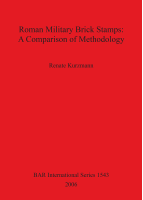Description
BOOK DESCRIPTIONThe purpose of this work is to determine the most informative articles and the most effective methods and research approaches to the study of Roman brick stamps covering the former Roman Empire. The different research methods used in different areas are compared. This study attempts to give an overall view of research methods, approaches and categories of studies used in all schools of brick stamp research and poses the question whether brick stamps can contribute to our understanding of military history. Regional and local differences of both stamps and modern schools of research are highlighted and their importance in terms of Roman history is discussed. This volume concentrates directly on questions such as: What are the different research methods used in dealing with military brick stamps, and who uses them? What are the different results represented by the different research approaches? Which results are best achieved by what methods? What can Roman military brick stamps contribute to an understanding of Roman history and can they be used as documents of military history, as other military inscriptions are? Or could they, instead, be helpful in reconstructing other historical aspects of Roman provinces? Are military brick stamps uniform documents which can be used equally in all former Roman provinces? The work concentrates on legionary rather than all military stamps. This study is intended to serve as a representative sample of the research methodologies for each province. Therefore, the focus lies on legionary stamps (but occasionally also includes auxiliary stamps where no other evidence exists). The author critically reviews a selection of articles, focusing primarily on the methodologies employed by certain scholars. The reviewed articles contain a selection of brick stamps. A catalogue of the works reviewed is included and the publications listed there form the background for this present analysis. The bibliography contains a list of all other works cited and consulted. Chapter 1 includes an introduction to the methodologies of studying brick stamps, concentrating on research methods and approaches. It also contains a discussion of the methodology used in this thesis, and also introductions to Roman bricks, and stamps on bricks, respectively.Chapters 2-9 analyse the different groups of research schools and the methodologies they employ in studying military brick stamps. Chapters 10-13 consider more general problems and questions which arise during the study of provincial military brick stamps, such as the phenomenon of name stamps, the question of when the habit of stamping bricks was started by the Roman army, the relationship between brick stamps and military territories or the so-called prata legionis and the problem of brick reuse. Chapter 14 summarises the answers to the research questions posed in the course of the previous chapters and offers a conclusion.











